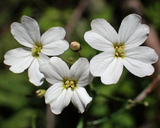Taxon Report
Cardamine angulata Hook.seaside bittercress |
 © 2021 Scot Loring |
Taxon Summary
Cardamine angulata, commonly known as seaside bittercress, is a perennial herb in the Brassicaceae that is found in California and elsewhere. It occurs within Lower montane coniferous forest, and North Coast coniferous forest, growing at elevations from 15 to 915 meters. Cardamine angulata is ranked 2B.2, Plants Rare, Threatened, or Endangered in California, But More Common Elsewhere; Moderately threatened in California.Classification
|
Scientific Name: |
Cardamine angulata Hook. |
|
Common Name: |
seaside bittercress |
| Family: | Brassicaceae |
| Element Code: | PDBRA0K010 |
| USDA Plants Symbol: | CAAN5 |
|
Synonyms/Other Names: |
|
Ecology and Life History
| Lifeform: | perennial herb |
| Blooming Period: (Jan)Mar-Jul | (Jan)Mar-Jul |
| Elevation: | 15-915 (50-3000) |
| General Habitats: | Lower montane coniferous forest, North Coast coniferous forest |
| Microhabitat: | Streambanks |
| Microhabitat Details: | wet areas |
Conservation Status
| CA Rare Plant Rank: | 2B.2 |
| Global Rank: | G4G5 |
|
State Rank: |
S3 |
| State List: | None |
| Fed List: | None |
| Other Status: | |
|
CRPR Changes: |
|
Occurrence Data from the CNDDB
| Total Occurrences: | 38 |
| Element Occurrence Ranks: | |
| Excellent (A) | 7 |
| Good (B) | 15 |
| Fair (C) | 5 |
| Poor (D) | 2 |
| None (X) | 0 |
| Unknown (U) | 9 |
| California Endemic: False | |
| California Counties and Islands: Name (Code) | |
| Del Norte (DNT), Humboldt (HUM), Marin (MRN), Mendocino (MEN) | |
| Quads: Name (Quad Code) | |
| Ah Pah Ridge (4112348), Arcata South (4012471), Bolinas (3712286), Childs Hill (4112461), Fern Canyon (4112441), Hales Grove (3912377), High Divide (4112481), Hiouchi (4112471), Holter Ridge (4112338), McWhinney Creek (4012461), Orick (4112431), Requa (4112451), Rodgers Peak (4112421), San Geronimo (3812216), Sister Rocks (4112462) | |
Threat List Data from the CNDDB
| Threat List Total: | 7 | |
| EOs with Threat Listed: | Total EOs | % of EOs |
| 24 | 63 % | |
| Logging | 15 | 39% |
| Road/trail construction/maint. | 7 | 18% |
| Erosion/runoff | 3 | 7% |
| Foot traffic/trampling | 3 | 7% |
| Altered flood/tidal/hydrologic regime | 2 | 5% |
| Other | 1 | 2% |
| Recreational use (non-ORV) | 1 | 2% |
Selected References
| Proposed Addition to CRPR 2.1, G5 / S1 (2012) |
Citation
California Native Plant Society, Rare Plant Program. 2025. Rare Plant Inventory (online edition, v9.5.1). Website https://www.rareplants.cnps.org [accessed 20 December 2025].